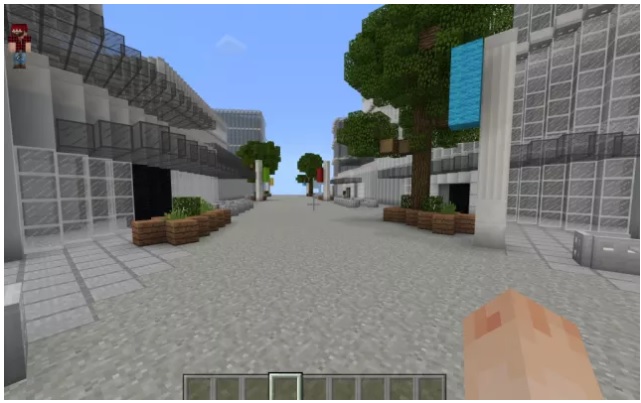
by Stone Marshall | Nov 22, 2018 | Awesome Book News, Free, Intro, Minecraft News, Minecraft questions, news, parent-news, State of Stone, Stone Marshall Book News, Stone Marshall Books, Stone Marshall Club, Stone Marshall Minecraft Adventures, Uncategorized |
Minecraft: Education Edition has received an update recently, and with the update comes its new Code Builder. The new tool brings a code-editing interface to the Minecraft worlds, allowing players to perform various tasks, such as creating custom Minecraft commands.
The Education Edition has a user base of more than two million players, and children who have the new update can open the code builder by simply hitting the C key (or the Access button at the top on tablets like the iPad), which opens the UI that allows the child to drag and drop customizable elements of code onto the canvas. Children can customize the text in the colored segments by changing variables such as items, numbers, and actions.
“Voyage Aquatic” lets leaners put together code tiles to solve puzzles.
The Education Edition is available on Windows 10, iPads, and macOS devices, with iPads being a very recent addition. Windows 10 computers and iPads should see the update hit automatically, however Mac users might need to install the update manually.

by Stone Marshall | Nov 22, 2018 | Awesome Book News, Free, Intro, Minecraft News, Minecraft questions, news, parent-news, State of Stone, Stone Marshall Book News, Stone Marshall Books, Stone Marshall Club, Stone Marshall Minecraft Adventures, Uncategorized |
Minecraft is widely popular for its open-ended structure, allowing players to mine, build, fight baddies or explore to their heart’s content. That structure has made it a surprisingly popular choice for modeling real-life buildings, including Microsoft’s new digital version of its upcoming campus.
Microsoft’s campus in Redmond, Wa., covers 500 acres of land and includes over 100 buildings. The campus is undergoing a renovation, slated to be finished in 2022, that will see 18 new buildings, several new sports fields and retail shops. During the design process, Riku Pentikainen, former Microsoft director of global workplace strategies for its real estate and facilities group, was inspired by watching his son play Minecraft, especially how simple and intuitive it was to create builds and walkthroughs.
Microsoft worked with Blockworks, a company that uses Minecraft to model real buildings, to create a digital version of the new campus that employees could walk through and familiarize themselves with.
While Minecraft is less accurate and naturalistic than other CAD and BIM applications, it lets players move easily and somewhat naturally through buildings, as well as make buildings quickly and without advanced training.
“When you build in Minecraft, you build everything in the perspective of the player, constantly being aware of the sense of scale,” James Delaney, Blockworks managing director, told CNBC. “Traditional CAD tools don’t allow for that sense of awareness.”
This isn’t the first big building project Microsoft has done with Minecraft, which it acquired in 2014 for $2.5 billion. Earlier this year, it partnered with Great Ormond Street Hospital in London to develop a complete model of the hospital. The model was created so kids and parents could tour the hospital beforehand, allowing them to alleviate potential anxiety about visiting the hospital and develop a knowledge of the floorplan. The hospital model includes elevator buttons made with the in-game power source “redstone,” which lets people teleport from floor to floor. The project was part of Minecraft’s Education Edition, an initiative to help educators use Minecraft.
Anyone with a 365 Education subscription can take a tour around the Microsoft digital campus. Though, Microsoft said its far from finished with the model. Going forward, it plans to include details like more realistic building interiors and people strolling through the campus.
“We’re trying to be very, very selective in how we’re going to do updates,” said Andrew Yang, project manager. “We want to make sure the next update is going to be meaningful and isn’t going to be updated too quickly.”
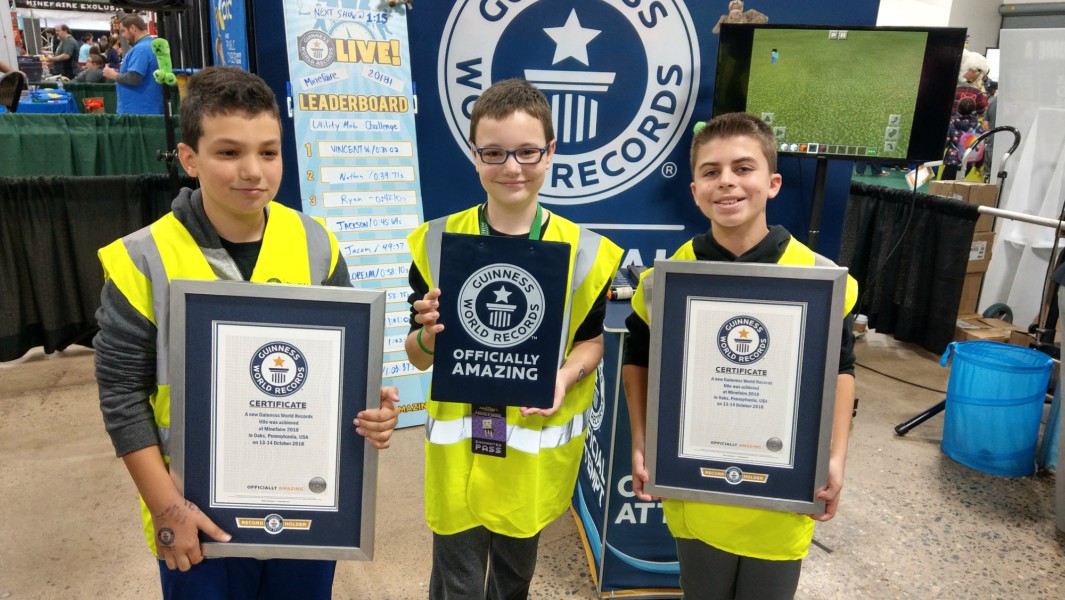
by Stone Marshall | Nov 21, 2018 | Awesome Book News, Free, Intro, Minecraft News, Minecraft questions, news, parent-news, State of Stone, Stone Marshall Book News, Stone Marshall Books, Stone Marshall Club, Stone Marshall Minecraft Adventures, Uncategorized |
Guinness World Records took Philadelphia Minefaire by storm the weekend of 13-14 October, offering live Minecraft record-breaking for attendees of all ages.
We partnered with Minefaire, the #1 Minecraft convention in the USA, to not only create a memorable and engaging fan experience but also introduce new readers to the Guinness World Records 2019: Gamer’s Edition.
Throughout the weekend, visitors had the chance to break three different Minecraft records, specially crafted for Philadelphia Minefaire.
Minefaire 3
Most sunflowers picked in one minute in the Sunflower Field in Minecraft (tablet)
The first record-breaking challenge presented to Philadelphia Minefaire attendees on 13 October 2018 was Most sunflowers picked in one minute in the Sunflower Field in Minecraft (tablet).
The first person to break to record was Sean Rosario (USA) who collected 65 sunflowers in 60 seconds. Shortly afterwards, eight-year-old Ezra Lyngdoh (USA) beat the record set by Sean, by collecting 68.
Later that afternoon, Nathan Cunningham (USA) wowed the crowd and broke the record again by picking 73 sunflowers in one minute.
Fastest time to climb to the top of Cliffside Village in Minecraft (tablet)
This proved to be the toughest challenge of the weekend as it challenged gamers to reach the roof of the house at the top of the ‘Cliffside Village’ while keeping the map selected for the duration of the attempt and without placing any blocks.
10-year-old Madie Mento (USA) was the first to break to record with a time of 1 minute 29.70 seconds. Minutes later, Garrett Muraesky achieved a new record with a time of 1 minute 19.99 seconds.
Fastest time to build all 3 utility mobs in Minecraft (tablet)
In a flurry of excitement on the Sunday, four separate challengers achieved this record.
The record was first set by Nathan Sepinwall (USA) with a time of 37.91 seconds. Minutes later both Vincent Watson (USA) and Ryan Mack (USA) smashed the record with times of 32.14 seconds and 25.88 seconds respectively.
The last record-breaker of the day was nine-year-old Chloe Hensley (USA) with a time of 25.08 seconds.
Minefaire 2
Love these records? You can learn more about the Minecraft Reader Challenges in Guinness World Records Gamer’s Edition 2019.
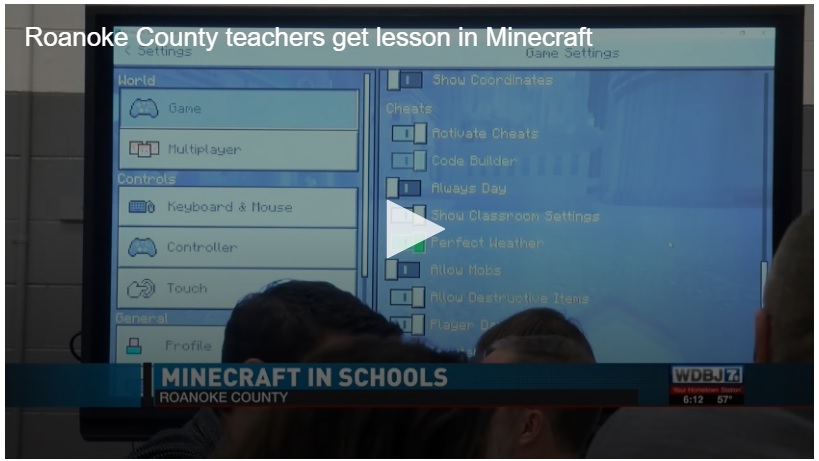
by Stone Marshall | Nov 21, 2018 | Awesome Book News, Free, Intro, Minecraft News, Minecraft questions, news, parent-news, State of Stone, Stone Marshall Book News, Stone Marshall Books, Stone Marshall Club, Stone Marshall Minecraft Adventures, Uncategorized |
According to teams with Microsoft Roanoke County is among the world’s top consumers of Minecraft globally. And teachers are using that to their advantage.
That includes second grade teacher Deede Clifford, who spent the day being the student.
“I can’t believe more teachers don’t use it,” she said of the game, “which is why I’m glad we’re having more in-services so more teachers will be on board with it.”
She’s getting trained by Microsoft teams on Minecraft in the school district’s administration building.
“I simply click on that download icon,” said the instructor, leading them through an exercise.
Minecraft is the video gaming sensation every kid and a few teachers are raving about.
“They love it and they ask every day to do Minecraft.” Clifford said of her students, ‘like they never wanna miss school, because they’re so afraid if they’re gonna miss if we do something with Minecraft one day.”
“I have achieved celebrity status at the elementary school,” said Meg Swecker, a Technology Resource Teacher.
She’s been using the educational version of Minecraft to teach students concepts they’re already supposed to be learning about.
“There’s a whole new way for them to be paying attention to what we want them to know,” she said.
The game is kind of like a hybrid of Tomagatchi and The Sims meets Legos: an interactive world where players have the freedom to build with an avatar.
For students that means using their imaginations to create the plant cells, maps and storybook scenes they’re learning about.
Most recently, Swecker was using it to have students recreated the Jamestown settlement.
If it seems a little complicated, don’t worry, say the teachers.
“You don’t have to know anything, the kids will teach you,” Clifford said. Which is really cool!”
The kids think it’s cool too, which is why these teachers are more than willing to meet them halfway.
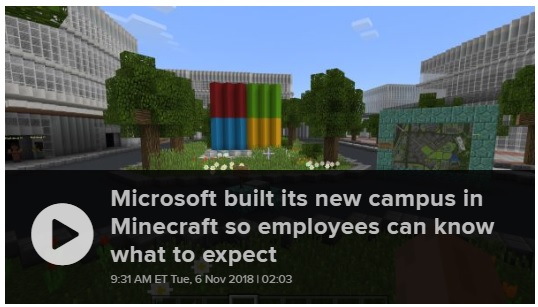
by Stone Marshall | Nov 20, 2018 | Awesome Book News, Free, Intro, Minecraft News, Minecraft questions, news, parent-news, State of Stone, Stone Marshall Book News, Stone Marshall Books, Stone Marshall Club, Stone Marshall Minecraft Adventures, Uncategorized |
Microsoft’s refreshed campus is scheduled to open in 2022, with 18 new buildings.
Designers are using the game Minecraft to give employees an early peek of how it will look.
Microsoft bought Minecraft parent Mojang in 2014 for $2.5 billion.
Four years ago Tuesday, Microsoft closed its $2.5 billion acquisition of Mojang, developer of the video game Minecraft. It was Satya Nadella’s first multibillion-dollar deal since taking over as CEO in February 2014.
As it turns out, Minecraft had more to offer Microsoft than just a wildly popular game with 91 million monthly active users and 250 million downloads. The technology is now being used to help employees get acquainted with a refresh of Microsoft’s sprawling campus in Redmond, Washington.
Earlier this year, Microsoft enlisted Blockworks, a company that uses Minecraft’s digital building blocks for designing real-world projects, to create a miniature rendering of the campus facelift, which is scheduled for completion in 2022. They’re using graphics that are far more immersive than two-dimensional photos and videos.
Microsoft’s corporate headquarters occupies 500 acres of land and houses more than 100 buildings. Rather than setting up an entirely new campus (or two) like Amazon, or following Alphabet, Apple and Facebook in expanding into new areas, the software company is updating its existing one, tearing down old buildings and erecting new ones, while also adding cricket and soccer fields and room for retail businesses.
Phil Spencer
✔
@XboxP3
It’s official, today we welcome Mojang to the Microsoft Studios family. We’re excited for the possibilities ahead w/the Minecraft community.
1,940
10:36 PM – Nov 6, 2014
Twitter Ads info and privacy
1,690 people are talking about this
Twitter Ads info and privacy
While Minecraft was designed for gamers, its immersive nature and the ability to quickly move around and construct edifices makes it easy to see how new buildings will look when inserted into an existing landscape. Microsoft recognized the potential of the game and introduced an education edition two years ago. It has racked up 35 million licensed users.
“When you build in Minecraft, you build everything in the perspective of the player, constantly being aware of the sense of scale,” said James Delaney, a managing director at Blockworks, which says on its website that it uses Minecraft “to create experiences, communities and learning environments.”
It’s only natural that a kid was involved in the idea of using Minecraft to miniaturize the new campus.
Riku Pentikainen, who until recently was director of global workplace strategies inside Microsoft’s real estate and facilities group, saw his son playing Minecraft earlier this year and was intrigued by how the game could help the company with its transition. Employees could learn and get excited about the remodeling long before they could check it out on foot, and in a more dynamic way than what was available through typical renderings.
Microsoft brought in architecture firm Gensler, along with Andrew Yang, a project manager, to work with internal staff, including Peter Zetterberg of Microsoft Studios, and Amy Stevenson, Microsoft’s archives manager, who provided pieces of history about campus landmarks. They got approval from Phil Spencer, Microsoft’s executive vice president for gaming, to use Minecraft for the project, Yang said.
From there, the group issued a request for proposals, ultimately deciding on Blockworks, which had done work for Disney, Warner Bros. and the Museum of London, as well as Microsoft. The mandate for Blockworks was to have a virtual campus set up within a few weeks, in time for a Microsoft hackathon on July 27.
Satya Nadella, chief executive officer of Microsoft Corp.
David Paul Morris | Bloomberg | Getty Images
Satya Nadella, chief executive officer of Microsoft Corp.
A half-dozen people at Blockworks began constructing buildings off drawings from Gensler. Delaney said Minecraft forces designers to sacrifice some accuracy because structures in real life don’t always have the game’s squared-off look, but the speed and ease of use more than made up for those deficiencies. It might take just 10 minutes to wrap up a single building, he said.
Minecraft also appeals to a broader audience of younger people, who might not know how to use computer-aided design, or CAD, programs, which require extensive training and aren’t as collaborative.
“Traditional CAD tools don’t allow for that sense of awareness,” said Delaney, who explored the use of Minecraft as a way to democratize architecture during his studies at the University of Cambridge.
Microsoft employees — and anyone else with the education edition of Minecraft — can now take a digital tour of the new campus and see how plans are developing. Outside of Microsoft, that access requires a subscription to Office 365 Education.
Yang said people are impressed with what they’ve seen, but improvements are coming. For example, he expects to add details like more realistic building interiors and additional people walking around the campus.
“We’re trying to be very, very selective in how we’re going to do updates,” Yang said. “We want to make sure the next update is going to be meaningful and isn’t going to be updated too quickly.”
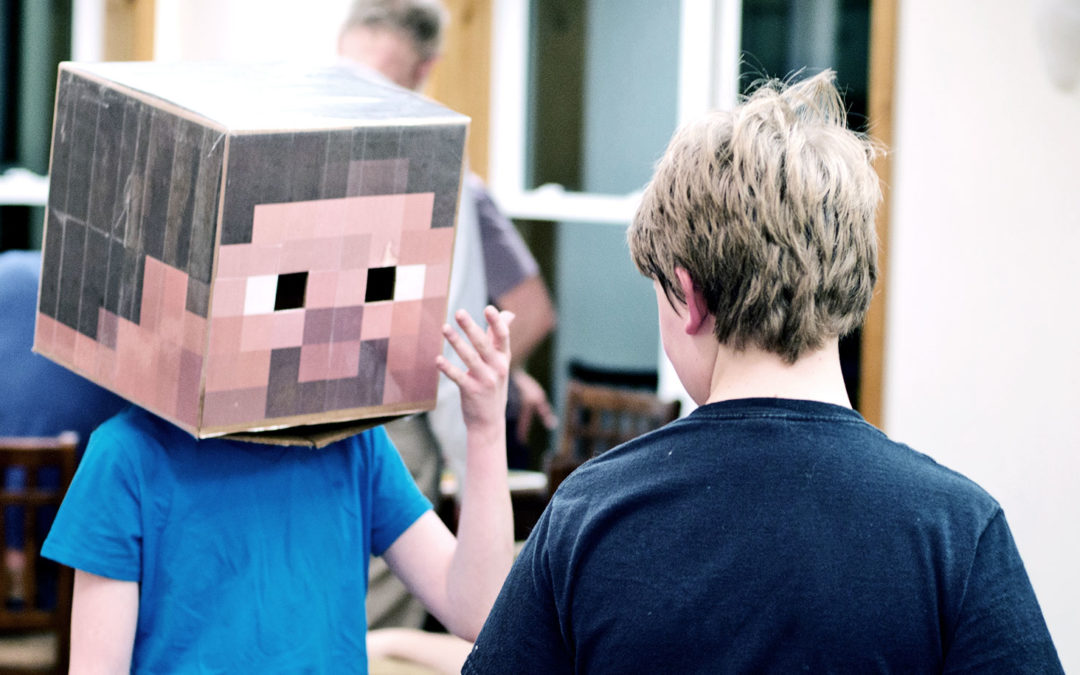
by Stone Marshall | Nov 20, 2018 | Awesome Book News, Free, Intro, Minecraft News, Minecraft questions, news, parent-news, State of Stone, Stone Marshall Book News, Stone Marshall Books, Stone Marshall Club, Stone Marshall Minecraft Adventures, Uncategorized |
Researchers have developed a Minecraft modification that uses artificial intelligence to help players improve their in-game architecture skills.
Minecraft is a popular 3D video game where players build and navigate their own digital environments. The modification will tell players whether their buildings fit into certain architectural styles and offer ideas for how the structures could be improved.
“One of the things that’s important to learn when you’re a kid and throughout life is creativity, abstraction—how to envision what you want and then create it,” says senior author Ross Knepper, assistant professor of computer science at Cornell University. “This is a tool that helps people not get discouraged, maybe if they’re beginning at Minecraft and don’t know how to use their imagination right off the bat.”
Minecraft temple
Erik Andersen created a model in Minecraft of a temple in Bangkok. (Credit: Cornell)
A.I. TEACHING PLAYERS
Based on buildings Minecraft players created and uploaded for others to use, the researchers created a deep neural network—a kind of machine learning trained to predict whether data belongs in a certain category. Through that network, players could learn whether their building is medieval, modern, Asian, or classical—four especially popular tags Minecraft players use. Once the building is classified, another algorithm can show the users similar buildings to inspire them to make improvements to their own.
“People are really interested in having more design spaces in Minecraft, and being able to build certain types of architecture, but there weren’t any design tools as far as we were aware that could teach them,” says first author Irene (Euisun) Yoon.
Yoon curated the data set to make sure the buildings were labeled correctly, since their algorithm was less accurate than they would have liked because it was trained with fewer than 1,000 player-created buildings. Ideally, they could train such an algorithm with tens or hundreds of thousands of pieces of data.
“If you ask an architect to tell you what a building’s style is, the architect will say, ‘OK, it’s one-and-a-half stories, it has dormers, it’s a Cape Cod.’ Deep learning is doing that but it’s doing it in a black box way (hidden from view). It learns patterns, but not necessarily the same patterns an architect would say are the key things,” Knepper says. For example, if all the modern-style houses in a data set have pools on the roof, the computer could assume that rooftop pools are a requirement for modern houses.
PLAYERS TEACHING A.I.
For Knepper, a roboticist by training, the Minecraft project helped answer questions about how a robot might follow a human’s instructions.
“If I say, ‘Build a house,’ today a robot is going to say, ‘I don’t know what that means.’ ‘Which brick should I put where?’ is the level at which robots need instruction,” Knepper says. “We’d like humans to be able to interface with robots more like we interface with each other. So if I tell it to build a medieval house or an ancient house and give some of the high-level details, it would know at that point how to turn it into a plausible thing that does everything you want. We’re not there yet, but this is the first step towards that goal.”
Coauthor Bharath Hariharan, assistant professor of computer science, approached the research from the perspective of his own work in computer vision. In trying to interpret an image, scientists can train a computer to pick up cues such as shape and solidity, but may have trouble processing perspective or scale. Using people’s intelligence through their Minecraft structures and tags can help computers learn to solve those problems.
“When you’re working with images, it’s really hard to actually get at the essence of what something is,” Hariharan says. “A machine observing how people build can actually learn quite a bit about what shape is, what structure is, what buildings are.”
The researchers will present a paper on their work at the Association for the Advancement of Artificial Intelligence Conference on Artificial Intelligence and Interactive Digital Entertainment in Canada.
The paper is based on work supported by the National Science Foundation.
Source: Melanie Lefkowitz for Cornell University
Original Study




